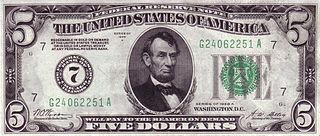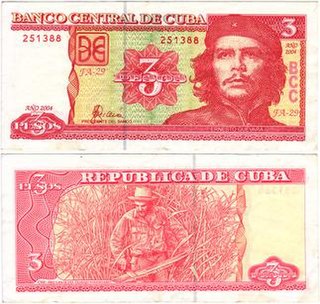Banknotes
The Government of Canada intended to release the banknotes on the same day as the official opening of the Bank of Canada. [7] It required months of work and preparation for the design, approval, and production of the banknote series. [8] Designs for the banknotes were created by the Canadian Bank Note Company (CBN) and the British American Bank Note Company (BABN, now BA International), both of which had designed and printed the preceding Dominion of Canada banknotes. [7]
The Government of Canada, officially Her Majesty's Government, is the corporation responsible for the federal administration of Canada. In Canadian English, the term can mean either the collective set of institutions or specifically the Queen-in-Council. In both senses, the current construct was established at Confederation through the Constitution Act, 1867—as a federal constitutional monarchy, wherein the Canadian Crown acts as the core, or "the most basic building block", of its Westminster-style parliamentary democracy. The Crown is thus the foundation of the executive, legislative, and judicial branches of the Canadian government. Further elements of governance are outlined in the rest of the Canadian Constitution, which includes written statutes, court rulings, and unwritten conventions developed over centuries.

The Canadian Bank Note Company (CBNC) is a Canadian security printing company. It is best known for holding the contract with the Bank of Canada to supply it with Canada's banknotes. The company's other clients include private businesses, national and sub-national governments, central banks, and postal services from around the world. In addition to bank notes, the company produces passports, driver's licences, birth certificates, postage stamps, coupons, and many other security-conscious document-related products. It also prints and provides document reading systems for identification cards, lottery tickets, stamps, and bank notes.
All but the commemorative $25 banknote began circulating on 11 March 1935, the same day that the Bank of Canada officially started operating. All banknotes contained the words "Ottawa, Issue of 1935" centrally at the top of the obverse, except for the $20 banknote, in which the words appeared below the serial number. [9] This is the only Bank of Canada series that includes $25 and $500 banknotes, and the only series that includes the official seal of the Bank of Canada. [10] The $500 banknote was a "carry-over from Dominion of Canada bank notes", and is the only Bank of Canada banknote series to include this denomination.
Other than the language in which they were printed, the English and French banknotes were the same. In May 1935, deputy governor of the Bank of Canada John Osborne wrote a letter to a colleague in England in which he stated that "the English-speaking population is inclined to mutilate the French notes, and the French population complains they cannot get enough of their own notes". [10]
The Governor of the Bank of Canada is chief executive officer and the chairman of the board of directors of the Bank of Canada; the incumbent governor is Stephen S. Poloz, who assumed the office on June 3, 2013. Poloz was formerly the head of Export Development Canada. The Governor and Deputy Governor shall be appointed by the directors with the approval of the Governor in Council. [See Bank of Canada Act 1985, Section 6 (1) http://laws-lois.justice.gc.ca/eng/acts/b-2/FullText.html]
All banknotes in the series measure 152.4 by 73.025 millimetres (6.000 by 2.875 in), slightly shorter and wider than the 1914, 1918, 1928, and 1934 Federal Reserve Notes in circulation in the United States at the time, and were described by The Ottawa Evening Citizen as a "novelty to Canada". They were printed on a material consisting of 75% linen and 25% cotton manufactured by the Howard Smith Paper Mills (now Domtar). [11]

The Series of 1928 was the first issue of small-size currency printed and released by the U.S. government. These notes, first released to the public on July 10, 1929, were the first standardized notes in terms of design and characteristics, featuring similar portraits and other facets. These notes were also the first to measure 6.14" by 2.61", quite a bit smaller than the large-sized predecessors of Series 1923 and earlier that measured 7.421 8" by 3.125"

Federal Reserve Notes, also United States banknotes, are the banknotes currently used in the United States of America. Denominated in United States dollars, Federal Reserve Notes are printed by the United States Bureau of Engraving and Printing on paper made by Crane & Co. of Dalton, Massachusetts. Federal Reserve Notes are the only type of U.S. banknote currently produced. Federal Reserve Notes are authorized by Section 16 of the Federal Reserve Act of 1913 and are issued to the Federal Reserve Banks at the discretion of the Board of Governors of the Federal Reserve System. The notes are then put into circulation by the Federal Reserve Banks, at which point they become liabilities of the Federal Reserve Banks and obligations of the United States.

The United States of America (USA), commonly known as the United States or America, is a country comprising 50 states, a federal district, five major self-governing territories, and various possessions. At 3.8 million square miles, the United States is the world's third or fourth largest country by total area and is slightly smaller than the entire continent of Europe, which is 3.9 million square miles. With a population of over 327 million people, the U.S. is the third most populous country. The capital is Washington, D.C., and the most populous city is New York City. Most of the country is located contiguously in North America between Canada and Mexico.
The banknotes were printed in greater variation of colour than the Dominion of Canada banknotes that had been previously issued. These were green for the $1 banknote, blue for the $2 banknote, orange for the $5 banknote, dark purple for the $10 banknote, rose for the $20 banknote, reddish brown for the $50 banknote, dark brown for the $100 banknote, sepia for the $500 banknote, and olive for the $1000 banknote. In April 1935, an article in The St. Maurice Valley Chronicle of Trois-Rivières stated that the appearance of the obverse of the $1 and $2 banknotes were too similar, particularly the green hue of the $1 banknote and the blue hue of the $2 banknote. It stated that the colours of the reverse were more distinct, but could be "confused in artificial light". The same article stated that the similarity between the English and French versions of the banknotes was a positive feature. For the 1937 Series banknotes, the Bank of Canada would change the colour of the $2 banknote to terracotta red to address the issue. [23]
The design of the banknotes was in a similar formal baroque style of the earlier Dominion of Canada banknotes, with wide variation between the denominations in the series. [10] The central numerals on the obverse of each denomination have a distinct background design, each with a portrait to the left. [10] The corner numerals and decoration are also different for each banknote denomination. [10]
Portraits
The royal portraits used for the engravings were based on older photographs of each member of the royal family, who were said to "appear younger than their years on the new notes". Depicted on the $1 banknote was George V. The portrait and design was approved by Edgar Nelson Rhodes on 10 May 1934. [24]
Queen Mary appeared on the $2 banknote, her portrait based on a photograph by Hay Wrighton that was engraved by Will Ford of the American Bank Note Company (ABN) and master engraver Harry P. Dawson of the BABN. [9] [25] The portrait of Edward, Prince of Wales wearing a colonel's uniform on the $5 banknote was based on a Department of External Affairs photograph taken by British photographer Vandyke and engraved by Dawson. [25] On the $10 banknote was a portrait of Princess Mary based on a photograph by official British Royal Family photographer Richard Speaight and engraved by Dawson. [25]
Princess Elizabeth at the age of 8 appears on the $20 banknote, the portrait based on a Marcus Adams photograph from 1934 for which an engraving was created by master engraver Edwin Gunn of ABN. [26] [27] The portrait of Prince Albert, Duke of York wearing an admiral's uniform on the $50 banknote was based on a photograph taken by Bertram Park, for which an engraving was made by Robert Savage of ABN. [28] It was subsequently used on six of the banknotes of the 1937 Series. [29] The $100 banknote includes a portrait of Prince Henry, Duke of Gloucester wearing the captain's uniform of the 10th Royal Hussars based on a photograph by Vandyke for which Ford created an engraving.
The portrait of John A. Macdonald wearing a fur-collared coat and engraved by Ford is on the $500 banknote (and was also used on the $100 banknote of the 1937 Series banknotes), and a Gunn engraving of Wilfrid Laurier wearing a Prince Albert coat is the portrait on the $1000 banknote. [27] [29]
Allegories
Each denomination had a reverse depicting an allegorical figure, the framing of which was different for each denomination. [10] Agriculture was depicted on the $1 banknote based on a painting by Alonzo Foringer of ABN, based off an engraving made by Will Jung. [9] A transportation allegory featuring the Roman mythological figure Mercury created by BABNC artists was on the $2 banknote, [9] electric power generation engraved by Dawson on the $5 banknote, [25] and of harvest engraved by Dawson on the $10 banknote. [25] The $20 bank note, also based on a painting by Alonzo Foringer of ABN, shows two allegorical figures representing toil. [26] An allegory of modern inventions is on the $50 banknote, and commerce and industry is on the $100 banknote. The fertility allegory on the $500 banknote was based on another painting by Foringer. [30] The allegorical figure of security on the $1000 banknote was previously used on a 1917 issue of Russian bonds. [27]
Commemorative $25 banknote
On 6 May 1935, the Bank of Canada issued a $25 banknote to commemorate the Silver Jubilee of the accession of George V to the throne. It was a royal purple banknote with the portraits of King George V and Queen Mary on the obverse engraved by Ford and Gunn, and a scene depicting Windsor Castle on the reverse engraved by Louis Delmoce of ABN. [26] It was the first commemorative banknote issued by the Bank of Canada. [31]
Printing
All printings of each denomination of the banknote series were signed by Graham Towers, the Governor of the Bank of Canada, and J.A.C. Osborne, the deputy governor. The English banknotes had serial numbers starting with the letter A, and the French banknotes had serial numbers starting with the letter F.
The Canadian Bank Note Company printed the $1 (series A and F), $20 (series A and F), $50 (series A and F), $100 (series A and F), $500 (series A and F), and $1000 (series A and F) banknotes, and the commemorative $25 banknote. The British American Bank Note Company printed the $2 (series A and F), $5 (series A and F), and $10 (series A and F) banknotes.

























































